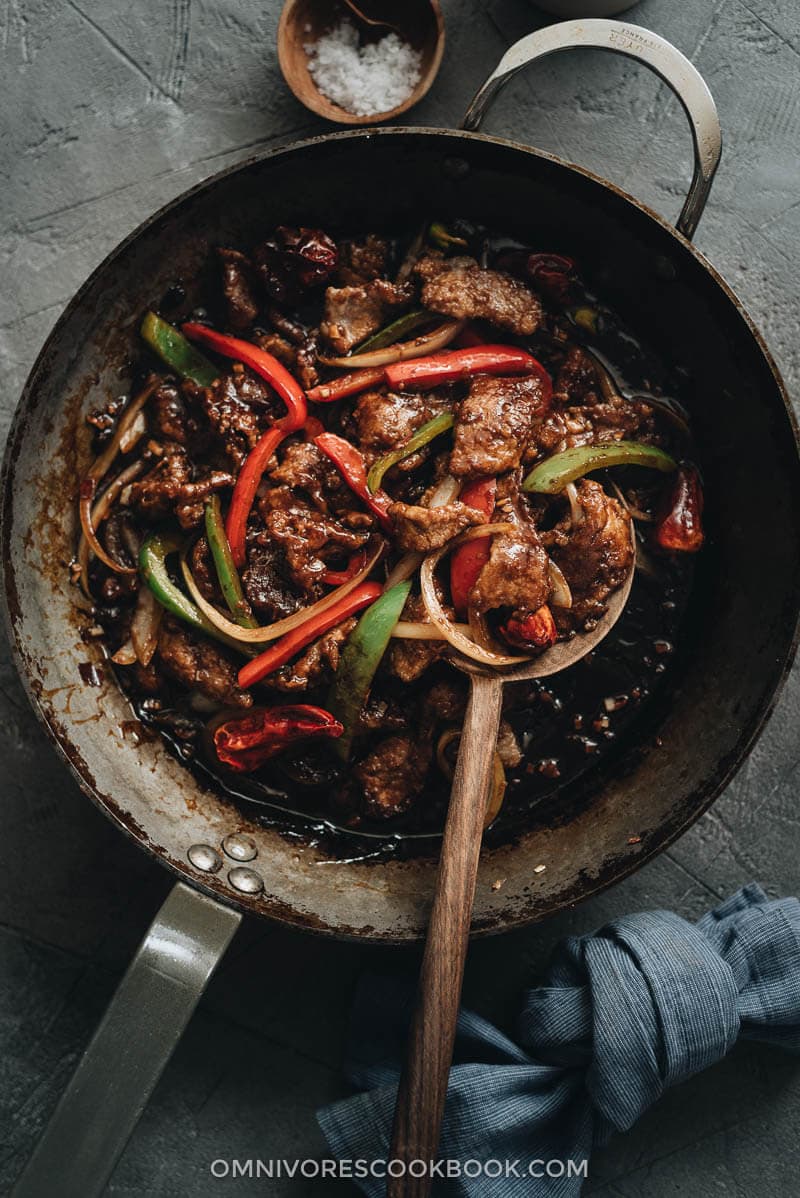
While a lot of Chinese recipes call for a wok and gas stove to make stir fry, I tend to disagree. Because this setup might not be practical for every home cook. As a personal example, I live in an apartment that has an electric stove, and it never generates heat fast enough for wok cooking.
After doing so many experiments with an electric stove, I finally found my own formula to create the best Chinese takeout dishes using a very simple setup with a nonstick skillet. Even better, my recipes do not require a ton of oil to deep fry the meat to create the crispy crust. For example, I’ve successfully recreated the restaurant version of Orange Chicken and Sesame Chicken without deep frying and simply use a nonstick skillet.
Today I want to share this Szechuan beef stir fry recipe. It requires a very simple setup and does not require deep frying. But it generates a result that’s even better than takeout. The beef is crispy on the outside and tender on the inside. The sauce is extra rich and full of aroma. Serve it on some steamed rice and your dinner will be ready!
Now let’s jump into the cooking process so you can learn all the secrets.
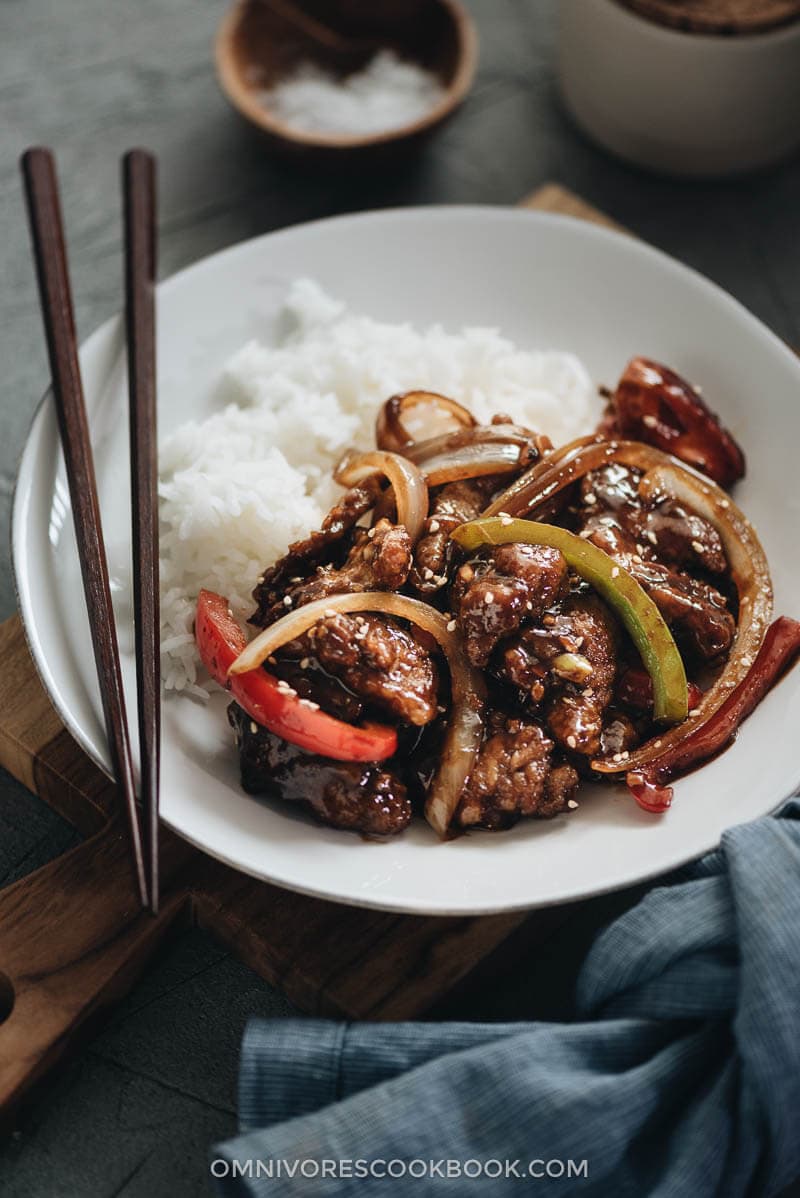
Szechuan Beef Cooking notes
1. Best cuts of beef to make stir fry
My favorite cut of beef for stir frying is flank steak. The cut is very tender and lean, and has just the right amount of marbling to keep it extra juicy. And it’s way cheaper than fancier cuts, such as tenderloin or ribeye. On the other hand, if you live in a place where flank steak is difficult to find or expensive, you can replace it with skirt steak or fajita cuts.
For an even cheaper alternative, you can use chuck roast or brisket. But remember, these cuts can be quite tough when stir fried. In this case, you should use the formula in my Orange Beef recipe, where I use baking soda to further tenderize the meat to create the desired soft texture. This is a practice that many Chinese restaurants use to create extra-tender beef with cheap cuts.
2. How to slice the beef for stir fry
Always slice against the grain, and try to create even thickness and size with your cuts. This is the foundation to creating tender meat in a stir fry.
In the pictures below, I demonstrate my approach to slicing a chunk of flank steak. First, I identify the direction of the grain. Then I slice along the muscle lines to create 3 small strips. And I cut perpendicular to the grain of each strip, to create evenly sized slices that are about 1/8” (4mm) thick and 2” (5cm) long.
It’s OK if you slice the beef slightly thicker. As long as it has a consistent thickness, the stir fry results will be consistent, without any overcooked or undercooked pieces.
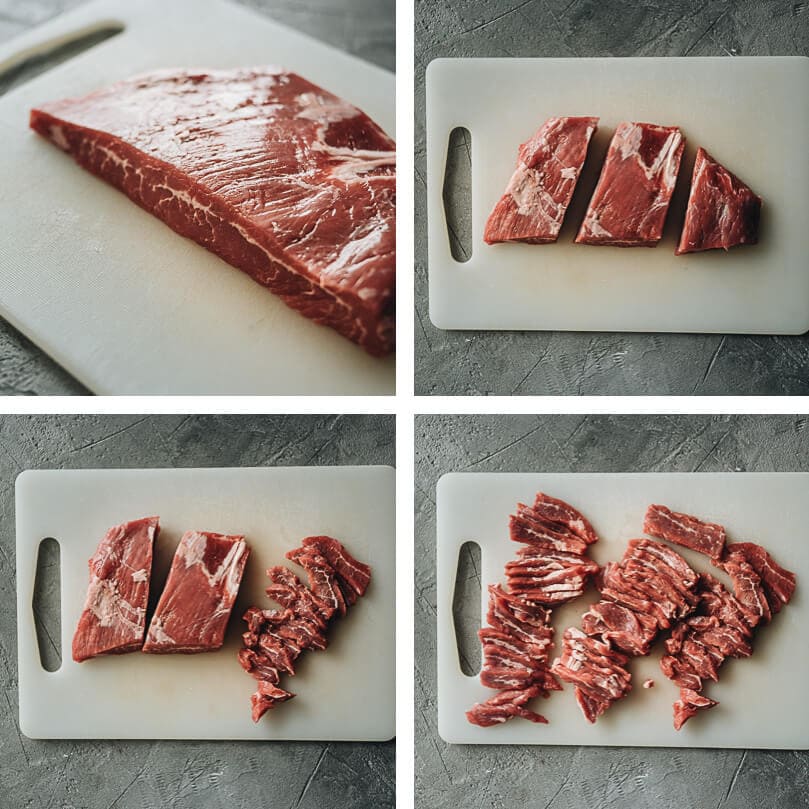
3. The secret formula to create crispy tender beef without deep-frying
Chinese restaurant usually deep fry the beef to create that heavenly crust. But that uses tons of oil and does require a wok. Not so practical in a home kitchen.
Here is a much easier approach.
The first step is to marinate the beef, which helps season and tenderize the beef. Then I coat the beef with extra cornstarch and pan fry it in a thin layer of oil. The combination of egg and cornstarch will create a crispy crust with minimal oil. You can probably get away with 1/4 cup of oil with a nonstick pan, or 1/3 of a cup of oil if using a cast iron or carbon steel pan.
It’s important to mix in the cornstarch right before you cook. Also, you should heat up the pan and the oil very well, until it is almost about to smoke.
Then you can add all the pieces into the pan and spread them out using a pair of tongs and your spatula. I personally prefer to use a pair of chopsticks to spread out the meat, to ensure that the beef slices are in contact with the hot pan. Remember, you should always leave the meat to sear in the pan without touching it, until the bottom is browned. It creates a better crust and minimizes sticking if you’re using a cast iron pan.
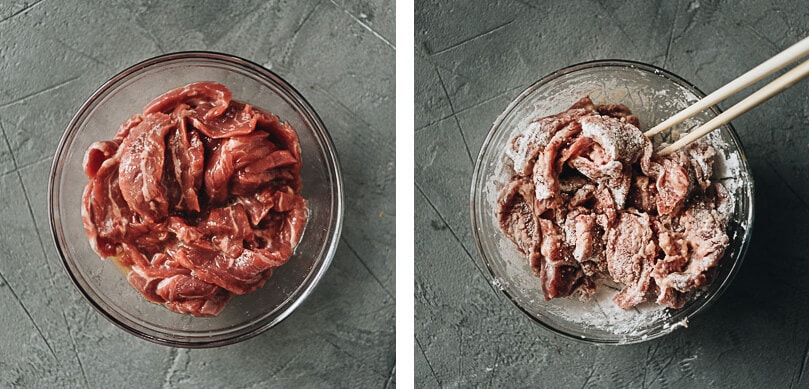
4. Extra rich Szechuan sauce
The two secret ingredients I use are Doubanjiang and homemade chili oil.
Doubanjiang (豆瓣酱), also called fermented spicy bean paste, is not your average hot sauce. It is a super rich, fermented, spicy paste made with dried fava beans, fresh chili peppers, salt, and wheat flour, then aged for between one and eight years. Doubanjiang has a deep savory, spicy and quite salty taste. It is a key ingredient in classic Sichuan dishes such as Mapo Tofu, Sichuan Eggplant Stir Fry, Sichuan Beef in Hot Broth, and Sichuan Fish with Pickled Mustard Greens. I use this ingredient to add spiciness and extra umami to the sauce. You can find it on Amazon or at The Mala Market.
Homemade chili oil is another booster to give the sauce a better aroma. However I do list it as an option, because you can skip it if you like your dish less spicy.
If you don’t have Doubanjiang, you can use another hot sauce as an alternative. For example, sambal oelek or sriracha. But do note that although the properties of the Szechuan sauce will change, it will still result in a delicious flavor.
5. Efficient workflow
This Szechuan beef recipe might look quite long and intimidating, but it actually only includes four steps:
- Slice the beef and marinate it.
- Mix the sauce.
- Chop the rest of the ingredients, such as aromatics and veggies.
- Make the stir fry.
Before you start cooking, you should have these bowls ready near your stove:
Marinated beef coated with cornstarch, a bowl of chopped ginger and garlic, a plate of chopped onion and pepper, mixed sauce, and dried chili peppers.
If you organize your ingredients in groups, the stir fry process will be so much easier.
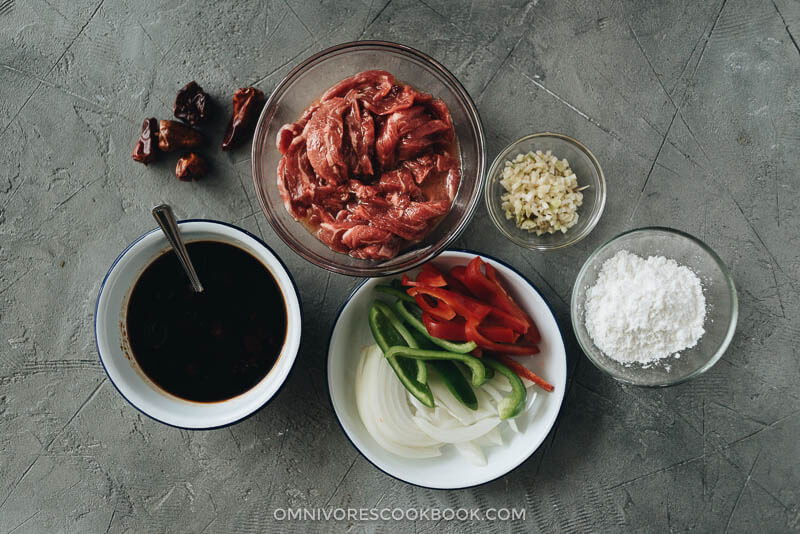

6. Add different veggies to your meal
You can replace the peppers with other types of veggies. Here is a simple way to add more greens to your table. You can use a small head of broccoli (seperated into bite-size florets), 2 cups of green beans, 4 cups of kale (chopped), or 1/2 lb spinach. Add the veggies into a big bowl and cover with plastic wrap. Heat them in the microwave in 1-minute increments, until the plastic expands, or until the veggies are cooked to your desired texture. It usually requires 1 to 2 minutes for leafy greens and up to 4 minutes for harder veggies.
Simply serve the microwave steamed veggies on the side and pour the beef and sauce over them. This recipe creates quite a saucy dish, so you will have plenty of sauce to cover the veggies.
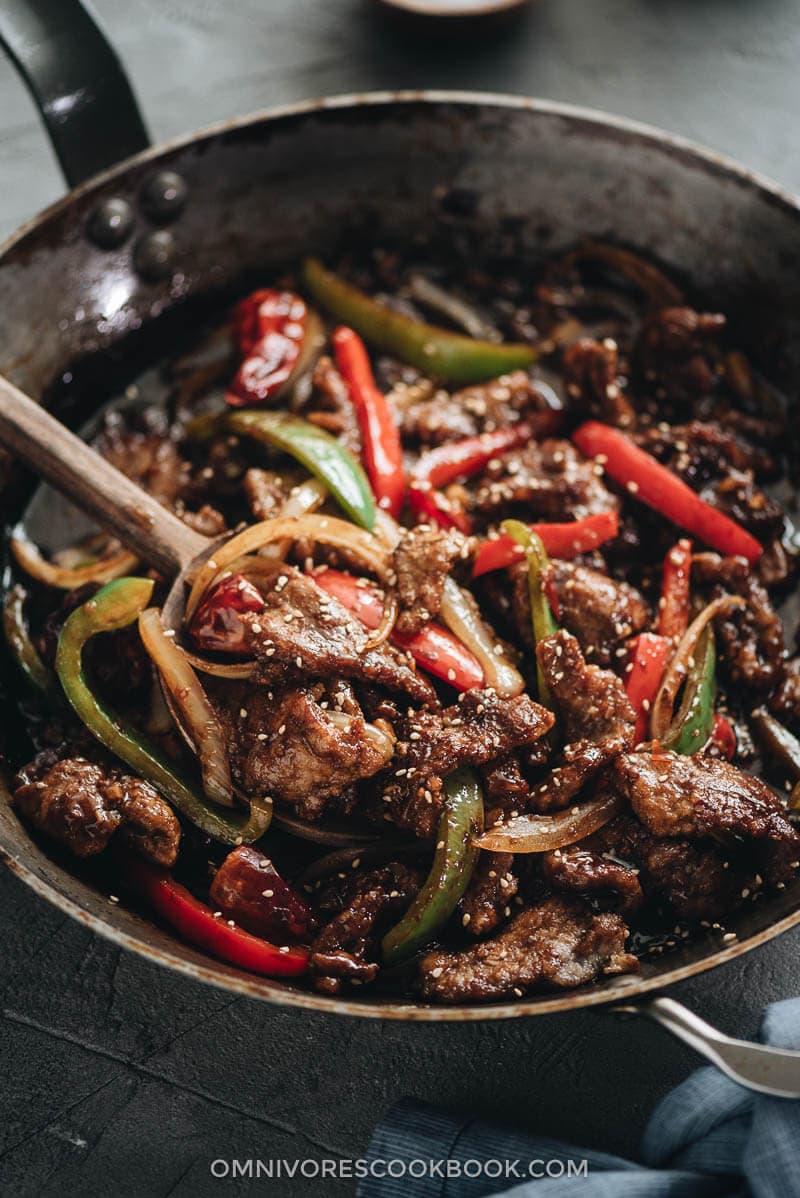
More homemade takeout recipes
If you give this recipe a try, let us know! Leave a comment, rate it (once you’ve tried it), and take a picture and tag it @omnivorescookbook on Instagram! I’d love to see what you come up with.
Chinese Cooking Made Easy
Are you new to this website? This free email series is a great place to start. I’ll walk you through a few of my most popular recipes and show you how and why they work. You’ll quickly start to cook better Chinese food in your own kitchen.
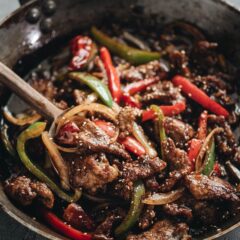
Real-Deal Szechuan Beef Stir Fry
Ingredients
Marinade
- 1 lb flank steak , cut against the grain to 1/8” (4-mm) slices (*Footnote 1)
- 1 egg , beaten
- 1 tablespoon peanut oil (or vegetable oil)
- 1/2 teaspoon salt
Sauce
- 3 tablespoons Chinkiang vinegar (*Footnote 2)
- 2 tablespoons Shaoxing wine
- 1 tablespoon light soy sauce (or soy sauce)
- 1 tablespoon dark soy sauce (or soy sauce) (*Footnote 3)
- 1 tablespoon homemade chili oil (Optional)
- 1 tablespoon Doubanjiang (fermented chili bean paste) (*Footnote 4)
- 1/2 cup beef stock (or water)
- 3 tablespoons sugar
- 1 tablespoon cornstarch
Stir-fry
- 1/3 cup cornstarch
- 1/3 cup peanut oil (or vegetable oil)
- 1/4 white onion , sliced
- 1 bell pepper , thinly sliced (I used half red and half green)
- 4 Chinese dried chili peppers
- 1 tablespoon ginger , minced
- 1 tablespoon garlic , minced
- Roasted sesame seeds for garnish (Optional)
Instructions
Marinate the beef
- Beat the egg in a medium sized bowl. Add the sliced beef, vegetable oil, and salt. Mix well and let marinate for 15 to 20 minutes while preparing the other ingredients.
Mix the sauce
- Combine everything for the sauce in a big bowl and mix well.
Stir fry
- When you’re ready to cook, drain the extra liquid from the bowl of beef. Add the cornstarch. Stir to coat the beef, until it forms an uneven coating with a little dry cornstarch left unattached.
- Heat oil in a large nonstick skillet (or a cast iron pan) over medium high heat until hot. Add the beef and spread into a single layer in the skillet. Separate the beef pieces with a pair of tongs or chopsticks.
- Cook without touching the beef for 2 to 3 minutes, or until the bottom turns golden. Flip to brown the other side, 1 to 2 minutes. Transfer the beef to a big plate and remove the pan from the stove. Let cool for 2 to 3 minutes.
- Place the pan back onto the stove and turn to medium heat. You should still have 1 to 2 tablespoons of oil in the pan. If not, add more.
- Add the onion, pepper, and dried chili pepper. Cook and stir for 1 minute.
- Add the ginger and garlic. Stir a few times to release the fragrance.
- Stir the sauce again to dissolve the cornstarch completely. Pour into the pan. Stir and cook until it thickens a bit.
- Add back the beef pieces. Stir to coat beef with sauce.
- Transfer everything to a plate immediately and garnish with roasted sesame seeds, if using.
- Serve hot over steamed rice as a main dish.
Notes
- To make the dish gluten-free, use rice vinegar to replace Chinkiang vinegar, tamari or coconut aminos to replace soy sauce, and a gluten-free hot sauce such as Sriracha to replace the Doubanjiang.
- Flank steak is my favorite cut for this dish, but you can use skirt steak, short ribs, or fajita meat, as well. If you decide to use a cheaper cut, such as as brisket or chuck roast, refer to my Orange Beef recipe to see how to tenderize the meat using baking soda.
- You can use rice vinegar as an alternative, although the sauce will come out slightly different and less pungent.
- Dark soy sauce will add a beautiful caramel color to the beef. You can use regular soy sauce as well but the dish will come out with a lighter color.
- You can use other hot sauces such as Sriracha, sambal oelek, etc. The sauce will come out differently but still be tasty.
Nutrition

Did you make this recipe?
I’d love to hear how it turned out for you! Please take a moment to leave a 5-star rating ⭐️ and share your thoughts in the comments further down the page. It really helps others discover the recipe too.

BobB
5 stars in my house! Thanks for sharing. BobB
Patrick Freuler
I made this yesterday. I used flat iron steak for the beef. I followed the recipe exactly as I do with all your recipes the first time, and it turned out great. Just a hint of heat with a nice balance of sour and sweet.
Matt
This recipe is on regular circulation at our place. We love it. We add sugar snap peas and extra chilli to make it our own. Could this work with firm tofu instead of beef?
Maggie Zhu
You definitely could cook the dish with tofu. For the tofu, I recommend using the marinade from this recipe to make it more flavorful: https://omnivorescookbook.com/general-tso-tofu/
Tomer C.
Hi,
No Szechuan peppers in the recipe?
Mario Fiorilli
This recipe is out of this world delicious, and easy to make. Following your instructions regarding organization and sequence, I was able to present my family with an incredibly better-than-takeout rendition of Sichuan beef. Love it, and will be trying many more of your recipes, including again tonight! Thank you Maggie!
Patrick
I made this for the second time today. As with most of Maggie’s recipes I don’t modify them. This was very tasty as is. I had all the ingredients on hand so that made it easy. It was just my wife and I and we have enough left over for two more lunch sized meals.
Wendy
A commenter had the idea of using black bean ,& garlic sauce that sounds good. If your allergic to an ingredient don’t use it.
Matt Hansford
Hi – imade
Hi, I made this a couple of weeks ago and thoroughly enjoyed every mouthful. Only change was to halve the sugar. Making it again tonight; I will add some sugar snap peas to up the vege content. Thanks for the recipe.
Pia
Ok, where is the Szechuan pepper in this so called authentic dish?
Ray
When I read this recipe, thought, wow, that’s a lot of sugar and a lot of sauce overall. But the reviews were so positive I decided to make it as written. After making it my reaction was, wow, that was too sweet for my taste, and really a lot of sauce.
This site is so inviting, that all continue to try some other recipes, but unfortunately this one did not hit the mark for me.
Gerry Shaer
Thoroughly enjoyed making m, serving and eating!
Richard
Yummy. I made this tonight but instead I used chicken and substituted the beef broth with chicken stock. It came out great.
Peggy KS
Wow. Amazing. So I had to sub a few things I didn’t have on hand. I used oyster sauce I place of fermented-bean-paste and used Japanese plum wine for Shaoxing wine. I also had a garlic chilli oil I used instead of homemade chilli oil.
Overall it came to get her wonderfully. I was surprised frankly at how easy it was. The beef was ridiculously tender and had a crispy coating. I used peanut oil – which I find always wonderful for cooking at higher heats.
The taste was a bit less spicy than I like but that’s my own fault and also it had a bit of a bitter end taste but nothing that wasn’t palatable. I’m thinking I added too
much dark soy sauce. I doubled the recipe and all the ingredients. I also added more veggies. zucchini and carrots and cooked them in the pan along with the peppers and onions. I microwaved the broccoli.
Overall this is great. It meets the sweet/savoury/spicy taste I love in Szechuan beef. Thank you so much!’
Amy D
I love your recipes and with this one, I would cut the vinegar by half. Also, I had a lot of sauce and it was a bit drowning. I LOVE the tips about cooking the beef, right on.
Bukky A
Awesome. Really awesome
Bukky A
Delicious. I’ve made it about 5 times already. 3 times within 2 weeks.
Marija
This was my hubby’s birthday dinner. We literally licked the plates clean… The beef was silky and tender, the sauce perfectly balanced, and the veggies provided another layer of texture and flavor (I also threw in a couple of leaves of Swiss chard). Divine.
Gail
This was the first recipe from Omnivore Cookbook that I’ve tried and it was absolutely delicious. We like things medium spicy so I only added three dried chili peppers and no chili oil. Next time I will add all four and a teaspoon of chili oil. My husband and I both loved it. Thank you for the great dinner.